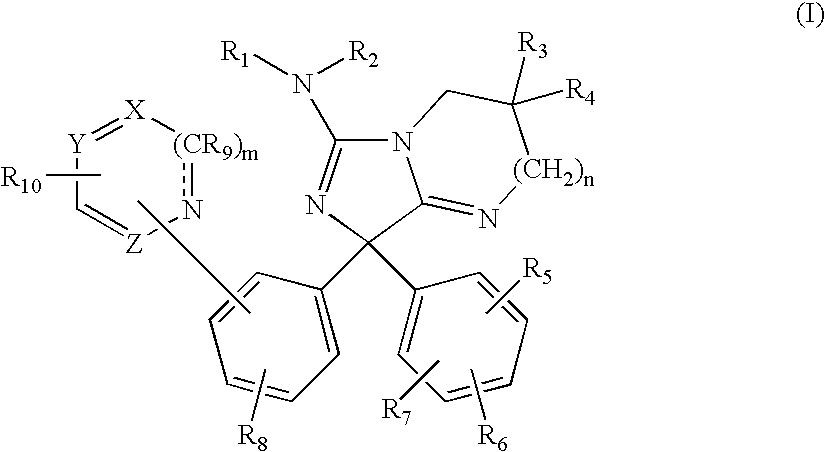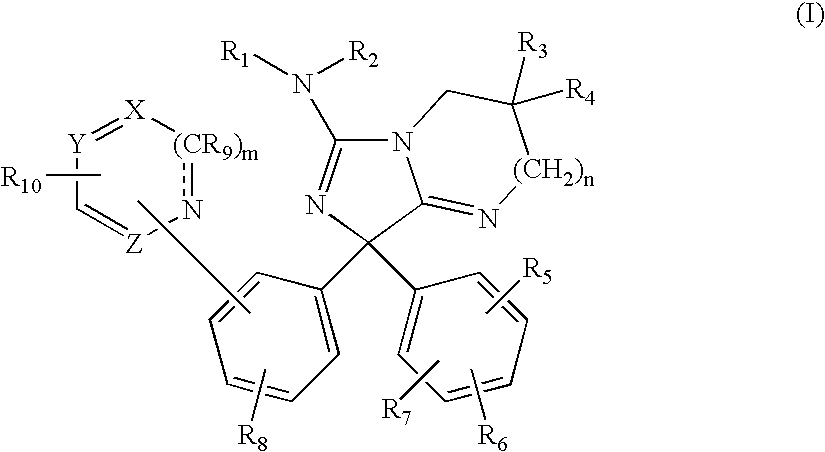Diphenylimidazopyrimidines as inhibitors of beta-secretase
a technology of beta-secretase and pyrimidine, which is applied in the direction of biocide, drug composition, cardiovascular disorder, etc., can solve the problems of severe impairment, eventual death, and serious healthcare problems, and achieve the effects of improving -amyloid levels, preventing or reducing disease, and improving treatment, prevention or improving diseas
- Summary
- Abstract
- Description
- Claims
- Application Information
AI Technical Summary
Benefits of technology
Problems solved by technology
Method used
Image
Examples
example 1
Preparation of 2-(3-Bromobenzoyl)-1H-imidazole
[0094]
[0095]A solution of imidazole (2.66 g, 39.1 mmol) and triethylamine (Et3N) 8.03 g, 79.4 mmol) in pyridine at 0° C. is treated with 3-bromobenzoyl chloride (17.5 g, 79.9 mmol), stirred for 5 min, allowed to warm to room temperature for 45 min, treated with an aqueous sodium hydroxide solution (7.5 N, 20 mL, 150 mmol), heated at reflux temperature for 2 h, cooled to room temperature, diluted with water, further cooled with an ice bath for 1 h and filtered. The filtercake is washed with water and dried under vacuum at 50° C. overnight to afford the title compound as a light tan solid, 4.89 g (50% yield), identified by NMR and mass spectral analyses. 1H NMR (500 MHz, CDCl3) δ 10.58 (br s, 1H), 8.73 (t, J=1.8 Hz, 1H), 8.61 (dt, J=7.8, 1.2 Hz, 1H), 7.75-7.72 (m, 1H), 7.42-7.38 (m, 2H), 7.32 (s, 1H); ESI MS m / z 250 [C10H7BrN2O+H]+.
example 2
Preparation of 1-(3-Bromophenyl)-1-(imidazol-2-yl)-1-[4-(trifluoromethoxy)phenyl]methanol
[0096]
[0097]A mixture of magnesium (0.644 g, 87.7 mmol) in THF (13 mL) at 50° C. is treated dropwise with a solution of 1-bromo-4-(trifluoromethoxy)benzene (6.32 g, 26.2 mmol) in THF over a period of 5 min, stirred at 50° C. for an additional 1.5 h, cooled to room temperature, treated with copper(I) iodide (0.041 g, 0.215 mmol) and a solution of 2-(3-bromobenzoyl)-1H-imidazole (2.60 g, 10.4 mmol) in THF, heated at 65° C. overnight, cooled to room temperature and diluted with a 1:1:1 mixture of ethyl acetate, water and saturated aqueous ammonium chloride. The phases are separated and the aqueous phase is extracted with ethyl acetate. The combined organic extracts are dried over sodium sulfate, filtered and concentrated. The resultant residue is purified by flash chromatography (silica, 85:15 to 75:25 hexanes / ethyl acetate as eluent) affords the title product as a yellow solid, 3.47 g (81% yield),...
example 3
Preparation of 1-(3-Bromophenyl)-1-(imidazol-2-yl)-1-[4-(trifluoromethoxy)phenyl]methylamine
[0098]
[0099]A mixture of 1-(3-bromophenyl)-1-(imidazol-2-yl)-1-[4-(trifluoromethoxy)phenyl]methanol (1.89 g, 4.57 mmol) and thionyl chloride (2.13 g, 17.9 mmol) in benzene is heated at 80° C. for 3 h, cooled to room temperature and concentrated in vacuo to dryness. This orange solid residue is dispersed in isopropanol, bubbled with ammonia gas at ice-bath temperature until the solution is saturated. This ammonia saturated solution is heated in a sealed tube at 35° C. overnight, cooled to room temperature, concentrated and partitioned between chloroform (50 mL) and 1 N HCl (50 mL). The phases are separated and the organic phase is washed with additional 1 N HCl. The combined HCl washes are cooled to 0° C., basified to pH>10 by the addition of solid sodium hydroxide and extracted with chloroform. The combined chloroform extracts are dried over sodium sulfate, filtered and concentrated to afford...
PUM
| Property | Measurement | Unit |
|---|---|---|
| temperature | aaaaa | aaaaa |
| temperature | aaaaa | aaaaa |
| temperature | aaaaa | aaaaa |
Abstract
Description
Claims
Application Information
 Login to View More
Login to View More - R&D
- Intellectual Property
- Life Sciences
- Materials
- Tech Scout
- Unparalleled Data Quality
- Higher Quality Content
- 60% Fewer Hallucinations
Browse by: Latest US Patents, China's latest patents, Technical Efficacy Thesaurus, Application Domain, Technology Topic, Popular Technical Reports.
© 2025 PatSnap. All rights reserved.Legal|Privacy policy|Modern Slavery Act Transparency Statement|Sitemap|About US| Contact US: help@patsnap.com



